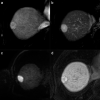Evaluation and Prediction of Treatment Response for Hepatocellular Carcinoma
- PMID: 36792205
- PMCID: PMC10086401
- DOI: 10.2463/mrms.rev.2022-0118
Evaluation and Prediction of Treatment Response for Hepatocellular Carcinoma
Abstract
The incidence of hepatocellular carcinoma (HCC) is still on the rise in North America and Europe and is the second leading cause of cancer-related mortality. The treatment of HCC varies, with surgery and locoregional therapy (LRT) such as radiofrequency ablation and transcatheter arterial chemoembolization, and radiation therapy being the primary treatment. Currently, systemic therapy with molecular-targeted agents and immune checkpoint inhibitors (ICIs) is becoming a major treatment option for the unresectable HCC. As the HCC after LRT or systemic therapy often remains unchanged in size and shows loss of contrast effect in contrast-enhanced CT or MRI, the response evaluation criteria in solid tumors (RECIST) and World Health Organization criteria, which are usually used to evaluate the treatment response of solid tumors, are not appropriate for HCC. The modified RECIST (mRECIST) and the European Association for the Study of the Liver (EASL) criteria were developed for HCC, with a focus on viable lesions. The latest 2018 edition of the Liver Imaging Reporting and Data System (LI-RADS) also includes a section on the evaluation of treatment response. The cancer microenvironment influences the therapeutic efficacy of ICIs. Several studies have examined the utility of gadoxetic acid-enhanced MRI for predicting the pathological and molecular genetic patterns of HCC. In the future, it may be possible to stratify prognosis and predict treatment response prior to systemic therapy by using pre-treatment imaging findings.
Keywords: hepatocellular carcinoma; locoregional therapy; magnetic resonance imaging; systemic therapy; treatment response.
Conflict of interest statement
The authors declare no conflicts of interest directly relevant to the content of this article.
Figures







Similar articles
-
Evaluation of HCC response to locoregional therapy: Validation of MRI-based response criteria versus explant pathology.J Hepatol. 2017 Dec;67(6):1213-1221. doi: 10.1016/j.jhep.2017.07.030. Epub 2017 Aug 18. J Hepatol. 2017. PMID: 28823713
-
Evaluation of treatment response in hepatocellular carcinoma in the explanted liver with Liver Imaging Reporting and Data System version 2017.Eur Radiol. 2020 Jan;30(1):261-271. doi: 10.1007/s00330-019-06376-5. Epub 2019 Aug 15. Eur Radiol. 2020. PMID: 31418085 Free PMC article.
-
mRECIST and EASL responses at early time point by contrast-enhanced dynamic MRI predict survival in patients with unresectable hepatocellular carcinoma (HCC) treated by doxorubicin drug-eluting beads transarterial chemoembolization (DEB TACE).Ann Oncol. 2013 Apr;24(4):965-73. doi: 10.1093/annonc/mds605. Epub 2012 Dec 5. Ann Oncol. 2013. PMID: 23223331 Clinical Trial.
-
Evaluation of Hepatocellular Carcinoma Treatment Response After Locoregional Therapy.Magn Reson Imaging Clin N Am. 2021 Aug;29(3):389-403. doi: 10.1016/j.mric.2021.05.013. Magn Reson Imaging Clin N Am. 2021. PMID: 34243925 Review.
-
Locoregional therapies for hepatocellular carcinoma and the new LI-RADS treatment response algorithm.Abdom Radiol (NY). 2018 Jan;43(1):218-230. doi: 10.1007/s00261-017-1281-6. Abdom Radiol (NY). 2018. PMID: 28780679 Free PMC article. Review.
Cited by
-
ALBI-sarcopenia score as a predictor of treatment outcomes in hepatocellular carcinoma.Sci Rep. 2025 Apr 26;15(1):14621. doi: 10.1038/s41598-025-97295-7. Sci Rep. 2025. PMID: 40287454 Free PMC article.
-
Hepatocellular Carcinoma: The Evolving Role of Systemic Therapies as a Bridging Treatment to Liver Transplantation.Cancers (Basel). 2024 May 30;16(11):2081. doi: 10.3390/cancers16112081. Cancers (Basel). 2024. PMID: 38893200 Free PMC article. Review.
-
Deep learning of pretreatment multiphase CT images for predicting response to lenvatinib and immune checkpoint inhibitors in unresectable hepatocellular carcinoma.Comput Struct Biotechnol J. 2024 Apr 3;24:247-257. doi: 10.1016/j.csbj.2024.04.001. eCollection 2024 Dec. Comput Struct Biotechnol J. 2024. PMID: 38617891 Free PMC article.
-
Assessment of viable tumours by [68Ga]Ga-FAPI-04 PET/CT after local regional treatment in patients with hepatocellular carcinoma.Eur J Nucl Med Mol Imaging. 2025 May;52(6):2132-2144. doi: 10.1007/s00259-024-07062-5. Epub 2025 Jan 20. Eur J Nucl Med Mol Imaging. 2025. PMID: 39831967
References
-
- Tang A, Hallouch O, Chernyak V, Kamaya A, Sirlin CB. Epidemiology of hepatocellular carcinoma: target population for surveillance and diagnosis. Abdom Radiol (NY) 2018; 43:13–25. - PubMed
-
- Forner A, Reig ME, de Lope CR, Bruix J. Current strategy for staging and treatment: the BCLC update and future prospects. Semin Liver Dis 2010; 30:61–74. - PubMed
-
- Sala M, Llovet JM, Vilana R, et al. Initial response to percutaneous ablation predicts survival in patients with hepatocellular carcinoma. Hepatology 2004; 40:1352–1360. - PubMed
-
- Cescon M, Cucchetti A, Ravaioli M, Pinna AD. Hepatocellular carcinoma locoregional therapies for patients in the waiting list. Impact on transplantability and recurrence rate. J Hepatol 2013; 58:609–618. - PubMed
MeSH terms
Substances
LinkOut - more resources
Full Text Sources
Medical
Research Materials

